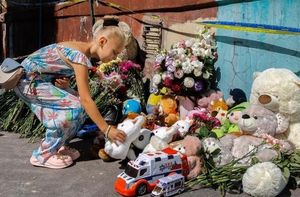In the early hours of Friday, August 29, 2025, a cloud of unease descended on one of Greenwich Village’s most storied addresses. The grand Beaux Arts co-op on Fifth Avenue—home to New York Times executive editor Joseph Kahn—became the latest site of protest in the ongoing debate over the newspaper’s coverage of the Israel-Gaza conflict. Red paint was splattered across the stately steps, walls, and sidewalk lamps of the 11-story building, and a stark message was scrawled in black marker on the pavement: “Joe Kahn Lies, Gaza Dies.”
According to NBC New York, police responded promptly to a call around 4:45 a.m., but as of now, no arrests have been made. The NYPD confirmed to The Post that the investigation remains ongoing. The incident fits a pattern seen in recent months: anti-Israel demonstrators targeting both Kahn personally and The New York Times as an institution, accusing the paper of slanted reporting on the war in Gaza.
In December 2024, a similar scene unfolded at The New York Times’ Midtown headquarters. Protesters stormed the building, daubing the entrance with red paint and leaving behind slogans nearly identical to those found at Kahn’s residence. These acts, while alarming, are not isolated, but rather part of a string of demonstrations by activists who argue that the Times’ coverage either downplays Palestinian suffering or, conversely, succumbs to what they call “Hamas propaganda.”
“People are free to disagree with The New York Times’s reporting but vandalism and targeting of individuals and their families crosses a line and we will work with authorities to address it,” a Times spokesperson stated, as reported by both NBC New York and The Post. The message was clear: while public debate is welcome, intimidation at private homes is not.
The building itself is a piece of New York history. Built in 1905, the limestone-clad, wrought-iron accented co-op has long been a magnet for the city’s elite. Its marble lobby boasts Art Nouveau bas reliefs, and its 42 apartments feature soaring ceilings, wood-burning fireplaces, and the kind of old-world grandeur that’s hard to come by in Manhattan. Kahn’s own unit last sold for about $1.6 million in 2009, but in recent years, larger apartments and penthouses in the building have commanded prices between $8 million and $17 million, according to Street Easy and The Post. Notable past residents include Hollywood legend Julia Roberts, who sold her penthouse there in 2005, as well as Marlon Brando and novelist Dawn Powell.
Yet, for all its prestige, the building’s latest notoriety comes not from celebrity, but from controversy. The New York Times, often called the “Gray Lady,” has faced withering criticism over its handling of the Israel-Gaza war. Activists and watchdog groups have accused the paper of biased language, sanitizing U.S. and Israeli policy, and downplaying the scale of Palestinian deaths. At the same time, others argue the Times has been too credulous of claims from Hamas and its affiliates.
The debate reached a fever pitch last month, when the Times published a front-page story on famine in Gaza. The article featured the case of 18-month-old Mohammed Zakaria al-Mutawaq, described as weighing as little as a 3-month-old due to starvation. After a wave of backlash from Israeli officials and pro-Israel commentators—who asserted that the boy suffered from pre-existing medical conditions—the Times appended a correction, clarifying that he had health problems “affecting his brain and muscle development.”
This correction did little to calm critics on either side. Some accused the Times of spreading misinformation or “manufacturing consent for genocide,” while others charged that the paper had bowed to political pressure and was underreporting the severity of famine, even as international bodies formally declared parts of Gaza to be in a state of famine. According to The Post, Israeli Prime Minister Benjamin Netanyahu has gone so far as to accuse the Times of defaming Israel and has publicly floated the idea of suing the newspaper.
Inside the Times newsroom, these external pressures have been matched by internal strife. Staffers have reportedly clashed over sourcing in investigations—particularly those probing allegations of sexual violence by Hamas. Unionized employees have also accused management of unfairly targeting Middle Eastern reporters, raising questions about inclusiveness and equity within the Times’ own ranks. These tensions are now under review by the publication’s leadership, as reported by both NBC New York and The Post.
Joseph Kahn, who took over as executive editor in 2022 after the departure of Dean Baquet, finds himself at the center of this storm. While some see him as a steward of the Times’ legacy of rigorous journalism, others have made him a lightning rod for criticism—sometimes in deeply personal ways, as Friday’s vandalism made all too clear.
The broader context is impossible to ignore. The Israel-Gaza war has polarized public opinion far beyond the Middle East, sparking protests, heated debates, and, increasingly, acts of civil disobedience and vandalism in cities across the globe. Media outlets—especially those with the reach and influence of The New York Times—are under intense scrutiny from all sides. Every word, every headline, every editorial choice is dissected, debated, and, as recent events demonstrate, sometimes met with direct action.
The Fifth Avenue co-op, with its storied past and famous residents, now finds itself a stage for these larger cultural and political battles. Residents awoke Friday not to the quiet luxury they’ve grown accustomed to, but to the unmistakable signs of protest: red paint, angry slogans, and the sense that the world’s conflicts are never as distant as they might seem.
For Joseph Kahn and the Times, the path forward remains fraught. The paper’s leadership has pledged to work with authorities to address the vandalism, but the deeper questions—about journalistic integrity, public accountability, and the boundaries of protest—are far from settled. As the investigation continues and the debate over the Times’ Gaza coverage rages on, one thing is certain: the intersection of journalism, activism, and personal privacy has never felt more precarious.
In a city where history and headlines often collide, the events of August 29 serve as a stark reminder of the stakes—and the scrutiny—that come with shaping the news.




